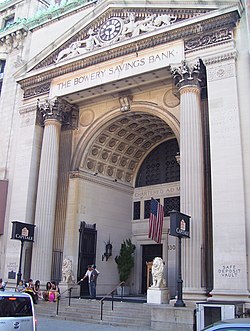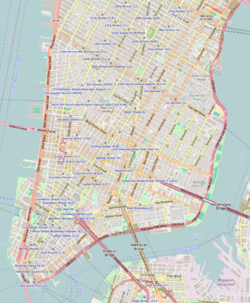Bowery Savings Bank
Bowery Savings Bank | |
 Original headquarters, designed by Stanford White | |
 Bowery Savings Bank | |
| Location | 130 Bowery, Manhattan |
|---|---|
| Coordinates | 40°43′7.49″N 73°59′43.84″W / 40.7187472°N 73.9955111°WCoordinates: 40°43′7.49″N 73°59′43.84″W / 40.7187472°N 73.9955111°W |
| Built | 1893–95 |
| Architect | Stanford White |
| NRHP reference No. | 80002672 [1] |
| Significant dates | |
| Added to NRHP | April 23, 1980 |
| Designated NYCL | April 19, 1966 |
The Bowery Savings Bank was a bank in New York City. It was chartered in May 1834 and is now part of Capital One Bank.
History[]
The Bowery Savings Bank opened in 1834 at the site of what is now 128-130 Bowery in Manhattan.[2] By 1980, it had over 35 branches located in the boroughs of Manhattan, Brooklyn, and Queens, as well as Nassau and Suffolk counties on Long Island. When bank deregulation was enacted, the bank began to suffer losses as a result of rising savings account interest rates. By 1982, the bank was running out of cash; in 1985, the Federal Deposit Insurance Corporation (FDIC) arranged for the bank to be sold to Richard Ravitch and others. It was sold for $100 million and allowed to maintain a capital deficit of $220 million rather than pay out on the $5 billion in deposits. In 1992, it was sold to H. F. Ahmanson & Co for $200 million.[3][4] The name was changed by 1992 to Home Savings of America.[5][6] In 1995, Ahmanson sold their New York operations to .[7][8] By 2004, Greenpoint had been sold to North Fork Bank,[9] and in 2007, North Fork was sold to Capital One Bank.[10]
From 1972 to 1992, baseball Hall-of-Famer Joe DiMaggio was spokesman for the Bowery Savings Bank.[11]
Timeline[]
- May 1, 1834 – New York State chartered the Bowery Savings Bank (May 1834–Oct 1985)
- October 22, 1920 – Universal Savings Bank acquired by merger
- February 14, 1949 – North River Savings Bank acquired by merger
- February 11, 1980 – Equitable Savings & Loan Association acquired by merger
- October 1, 1985 – Merge with The State Bowery Savings Bank
- April 20, 1992 – Name changed to Home Savings of America, Bowery Division, a state savings bank
- September 1, 1992 – Converted to Federal Home Savings of America, Bowery Division, a Federal savings bank
Buildings[]
130 Bowery and 124 Bowery[]

The bank's headquarters at 130 Bowery between Broome and Grand Streets was designed by Stanford White of the architecture firm of McKim, Mead & White, and built in 1893–95.[12] The "L"-shaped building continues from Bowery through to Elizabeth Street, and has a second entrance facade at 228 Grand Street.
White's choice of a Roman classical style for the building, a first, set a trend for bank buildings, first in New York, and then across the United States. The exterior features Corinthian columns and sculpted pediments by Frederic MacMonnies, while the interior gives the impression of a Roman temple, and is said to be one of the great spaces in New York.[12][13] It features the extensive use of marble, in the teller's counters — which are made of yellow — the walls, and the mosaic floors. In addition, White employed faux marble scagliola columns, coffered ceilings and stairs and skylights made of cast iron.[12]
The exterior of the original building was designated by the New York City Landmarks Preservation Commission as an official city landmark in 1966, and the interior was given the same designation in 1994.[12] It was added to the National Register of Historic Places in 1980. It is currently "Capitale", restaurant, night club and event space which is popular as a wedding site. In 2012, the connected building at 124 Bowery, designed by York & Sawyer and completed in 1902, was also designated a landmark.[14]
110 East 42nd Street[]

The bank decided to move its headquarters in 1920, and a new building was constructed from 1921 to 1923 at 110 East 42nd Street between Park and Lexington Avenues across from Grand Central Terminal in Midtown Manhattan. It was designed by York and Sawyer in Italian Romanesque Revival style, with William Louis Ayres as the partner in charge.[15] The huge interior, which measures 65 feet high, 80 feet wide and 197 1/2 feet long, utilizes marble, limestone, sandstone and bronze screens to create a space reminiscent of a basilica.[15] It has been called "one of the great spaces of New York."[16] A six-story addition to the east, which came to be called "The Chapel", was built in 1931–33.[15]
The building was designated a New York City landmark in 1996. The ground floor is now a Cipriani restaurant and upscale event space.
Archives[]
In April 2019, workers cleaning out a basement in Brooklyn discovered century-old records of the Bowery Savings Bank. Archivists moved rapidly to secure at least some of these records. While the historical value was not immediately known, a historian told The New York Times they could “be priceless”.[17]
In the 1920s, Henry Miller wrote a short text about the architecture of this bank, in a short text he called mezzotint and whose title was A Bowery Phoenix.
References[]
Notes
- ^ "National Register Information System". National Register of Historic Places. National Park Service. January 23, 2007.
- ^ "Bowery Savings Bank First Floor Interior" (PDF). Neighborhood Preservation Center. Retrieved May 24, 2014.
The Bowery Savings Bank building, constructed in 1893-93 on the site of the bank's first building ... (established 1834)
- ^ "Ahmanson to Buy Bowery Savings Bank of New York for $200 Million". Los Angeles Times. October 6, 1987.
- ^ Berg, Eric N. (October 6, 1987). "Bowery Savings Bank Is Sold for $200 Million". The New York Times.
- ^ Roosevelt, Phil (April 12, 1992). "N.Y.'s landmark Bowery Savings changing its name". Dallas Morning News. p. 15H.
The Bowery Savings Bank, founded in 1834, will become Home Savings of America on April 20, according to its Los Angeles-based parent, H.F. Ahmanson and Co. The thrift company said it is striving to establish a nationwide identity around the Home Savings of America moniker. That is the name of its flagship unit, the nation's largest thrift. Ahmanson, which acquired Bowery in 1988, said the Home Savings of America name also will be adopted by its two smaller New York thrifts -- Home Savings Bank and Savings of America
- ^ "The Company Name Game; Is Corporate America Having an Identity Crisis?". The New York Times. July 15, 1992.
Fleet-Norstar Financial Group became Fleet Financial Group and the Bowery Savings Bank took the name of its parent, Home Savings of America.
- ^ Iwata, Edward (May 15, 1995). "Ahmanson selling New York branches". San Francisco Chronicle.
- ^ Hansell, Saul (May 16, 1995). "Greenpoint to Pay $660 Million For 60 Home Savings Branches". The New York Times.
- ^ Atlas, Riva D. (February 17, 2004). "North Fork to Acquire GreenPoint Financial for $6.3 Billion". The New York Times.
- ^ Dash, Eric (March 13, 2006). "Capital One to Buy North Fork for $14.6 Billion". The New York Times.
- ^ The American Experience, PBS, archived from the original on April 25, 2009
- ^ Jump up to: a b c d NYCLPC, pp. 46–47
- ^ White & Willensky with Leadon, p.93
- ^ Postal, Matthew. "Bowery Bank of New York Building Designation Report" Archived November 3, 2012, at the Wayback Machine New York City Landmarks Preservation Commission (June 26, 2012)
- ^ Jump up to: a b c NYCLPC, p.107
- ^ White & Willensky with Leadon, p.314
- ^ "Spared From the Shredder (for Now): 'Priceless' Bank Records of Old New York". The New York Times. April 2, 2019. Retrieved April 5, 2019.
Bibliography
- New York City Landmarks Preservation Commission; Dolkart, Andrew S.; Postal, Matthew A. (2009). Postal, Matthew A. (ed.). Guide to New York City Landmarks (4th ed.). New York: John Wiley & Sons. ISBN 978-0-470-28963-1.
- White, Norval; Willensky, Elliot & Leadon, Fran (2010). AIA Guide to New York City (5th ed.). New York: Oxford University Press. ISBN 978-0-19538-386-7.
External links[]
| Wikimedia Commons has media related to Bowery Savings Bank. |
- Bowery Savings Bank Building at Emporis Buildings
- Photographs and architectural sketches of the Bowery Savings Bank Building
- The miracle of mutual savings, as illustrated by one hundred years of the Bowery savings bank Orcutt, William Dana (1870-1953) The miracle of mutual savings, as illustrated by one hundred years of the Bowery savings bank (New York, The Bowery Savings Bank, 1934)
- Buildings and structures on the National Register of Historic Places in Manhattan
- McKim, Mead & White buildings
- Defunct banks of the United States
- New York City Designated Landmarks in Manhattan
- Banks established in 1834
- 1834 establishments in New York (state)
- Banks disestablished in 1992
- American companies disestablished in 1992
- American companies established in 1834
- Bowery
- Beaux-Arts architecture in New York City
- New York City interior landmarks




